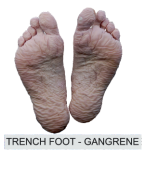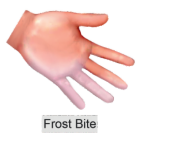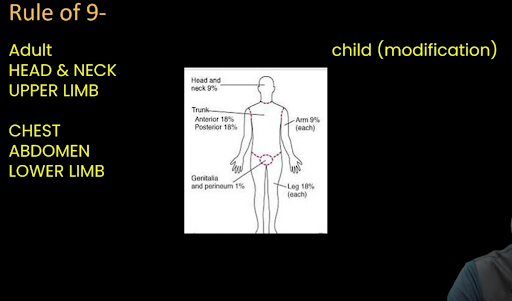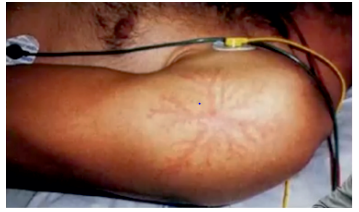Thermal Injury: Types, Causes, Signs and Symptoms, Treatment
May 25, 2023
Navigate Quickly
Grab 100 One-Liners in FMT – Download Free PDF!
Types of Thermal Injuries
A) Hypothermia
B) Trench foot
C) Frostnip
D) Frostbite
E) Heat Injury
Corrosive or Chemical Burns
Classification of burn
Necklacing
Wallace Rule Of 9
Rule of palm
Cause of Death in Thermal Injuries:
Non Specific Findings of Thermal Injuries:
Pugilistic attitude
Heat Rupture
Heat Hematoma
Heat fracture
Puppet organs
Electrocution: (electric shock)
Cause of death
Postmortem finding
Electric Mark (Joule burn)
Lightning injuries
Spencer Theory of Lightning
FAQs
Where can I find more information about thermal injuries?

Thermal burns are heat-related skin injuries that commonly result from coming into touch with hot objects, hot liquids, steam, or flames. The majority of burns are small and can be treated locally or as an outpatient procedure. Treatment in specialized burn centers is provided to about 6.5% of all burned patients. The amount of body surface area damaged, the depth of the burns, and specific patient characteristics like age, prior injuries, or other health issues are taken into consideration when deciding whether to transfer and receive treatment at burn centers.
Scale up your forensic medicine preparation with this blog on important topics for Pathology, and experience the best NEET-PG coaching available online.

Grab 100 One-Liners in FMT – Download Free PDF!
Types of Thermal Injuries
A) Hypothermia
It is a condition when the temperature goes below 35°C. It happens in old age people, alcoholic people, and in people with certain diseases.
Signs of hypothermia include clouding of consciousness, Disorientation, Loss of Reflex and Respiratory rate, heart rate, and blood pressure becomes low.
Hypothermia Postmortem finding After Death
- Skin becomes Pale that is why it is also known as white death
- Postmortem lividity: bright-pink in color
- Stomach mucosa: black-brown necrosis (wischnewski-spot)
- Fat necrosis: Pancreas (50% people)
- Lipid depletion: Adrenal gland
- Internal organs: Congested
Hypothermia has 3 phenomenon:
- Skin: Erythema pernio: it is red in color and has painful and pruritic lesions. After this it converts into blisters and oedema. It is also known as chill-blains.
- Paradoxical undressing: Homicide after sexual assault. In hypothermia, if the thermoregulatory center stops, it causes skin vasodilation. And then the core blood shifts to cutaneous and the person feels warmth and undress.
- Hide and Die Phenomenon: In this a person becomes disoriented, mental confusion is there and the person hides behind a bench, table, wardrobe, etc. and dies afterwards. That is why it looks like homicide after robbery.
B) Trench foot
It is also known as immersion foot. It is caused due to a moist cold. It occurs in soldiers, sailors and people in the trenches. The area becomes red, cyanosis, pulsations are absent, necrosis and gangrene formation occurs. It is seen at 5 to 8°C. If the hands are immersed in cold places, it is known as trench hands.

C) Frostnip
It is the first effect produced by dry cold and has a nonfreezing effect. It is a superficial injury and has non-permanent damage. The mechanism is vasoconstriction.There will be numbness, pall and burning sensation. The most common sites are the nose, ear, and face. Skin becomes hard and black in two weeks. It is always an antemortal injury.
Treatment includes rewarming at 42-44° C, protection from cold, and if there is an infection in the frostbite antibiotics and anti-tetanus treatment.
D) Frostbite
It is the second effect produced by dry cold and has a freezing effect. It can be superficial as well as deep injury and could be permanent damage. A mechanism is formation of ice crystals (because frostbite is seen at a freezing temperature of -2.5° c, so that will cause freezing effect and there will be the formation of ice crystals and which will produce ischemia as well as gangrene)
There are 2 types of frostbites:
Superficial Frostbite- In this Numbness,Burning sensation and Blisters with Clear fluid and itching may be present.
Deep frostbite- In this Blisters with hemorrhagic fluid become black because of necrosis and gangrene.

E) Heat Injury
Heat cramp- It is also known as a miner's cramp or fireman’s cramp. If there will be excessive heat outside, there will be a loss of electrolytes (sodium and potassium) and water, Because of this there will be muscle cramps in the hands, legs, and abdomen. It is common in people working in miners and fire industries. For Treatment fluids, and electrolytes are given.

Heat Exhaustion
It is also known as heat syncope or heat prostration. When there is excessive heat, sweating increases and there will be a loss of electrolytes and fluid(because of this there will be decreased venous return and it will cause decreased cerebral Perfusion ). Clinical features include fainting, dizziness, and lightheadedness. Pupil will be dilated and Skin remains cold and moist. Cause of death is vascular collapse or syncope. Treatment includes fluid therapy and elevation of the leg to increase the venous return.
Heat stroke
It is also known as sunstroke or thermic fever or heat hyperpyrexia. It is common; if you are working in sunlight, if you have increased muscle activity, if you have some infection, and if you have a very humid temperature. If your body temperature goes above 104°f /45° C, in this case, your sweating will stop and you will get a heat stroke because the thermo regulatory center stopped and the hypothalamus stopped working. Clinical features include altered mental status, disorientation, loss of consciousness. Pupils are constricted. Skin is dry and hot. Sweating is stopped which is known as anhidrosis.
Treatment - Remove the clothes, bath with ice water, ice pack, and oral and IV fluid, and use AC and fan to decrease the temperature.
Local Heat Injury
It occurs in Minimum Temperature of 44oC for upto 5 to 6 hours and 65oC for upto 45 Sec
|
Dry Heat Flame |
Moist heat scald Liquid/ Steam |
|
|
Scald and burn
Scald is a liquid or stem over the body more than 60 °C. If scald is a liquid or stem over the body more than 70 °C, it is called whole thick skin scald.
Corrosive or Chemical Burns
Ulcerated patches which are free from blisters. In this Hairs are not singed and the Red line of demarcation is absent. It Shows distinct coloration
| Cause | Dry heat | Moist Heat | Chemical |
| Flame | Scald | Corrosive | |
| Site | At and above contact | Below the site | Below the site |
| Splashing | Absent | Present | Present |
| Skin | Dry, wrinkled | Sodden, Bleached | Destroyed |
| Vesicles | At the circumference | Over the burnt area | Rare |
| Redline | Present | Present | Absent |
| Colour | Black | Bleached | Distinctive |
| Charring | Present | Absent | Present |
| Singeing | Present | Absent | Absent |
| Ulcer | Absent | Absent | Present |
| Scar | Thick, contracted | Thin, less contracted | Thick, contracted |
| Clothes | Burnt | Wet, non burnt | May be burnt |

Classification of burn
Burns are classified according to Wilson’s classification:
- 1° Burns aka Epidermal burns
- 2° Burns aka Dermo epidermal burns
- 3° Burns aka Deep burns
- 4 Degree burns: there is Complete charring of tissue

| Epidermal | Dermo epidermal | Deep | |
| Erythema (redness) | Present | Present | Skin and tissue become white and yellow coloured or black chairing of tissue forms eschar. |
| Pain | Present | Present | |
| Healing | Spontaneous and complete (takes 1 week) | If it involves the papillary dermis it takes 2 weeks. It is the reticular dermis, it takes 3 weeks. | |
| Scar | Absent | Present | |
| Blister | Absent | Present |
- Epidermal to dermo-epidermal, it is called superficial burn and from dermo-epidermal to deep burn, it is called deep burn.
- Dermoepidermal burns are the most painful burns because nerves are exposed.
- Deeper burns are relatively painless because the nerves which transmit the pain become lost.
- Epidermal has dupuytren's 1st and 2nd°, dermo epidermal has dupuytren's 3rd and 4th°, deep burn has dupuytren's 5th and 6th°.
- Epidermal has herbas 1st°, dermo epidermal has herbas 2nd°, deep burn has herbas 3rd°.
Necklacing
It is a homicidal burn,A method of homicide in South Africa. For killing, a tyre is used around and chest and an inflammable material. It is a burn Injury.
Wallace Rule Of 9
Wallace Rule Of 9 is used for ESTIMATION OF TOTAL BODY SURFACE AREA IN BURNS. Wallace Rule Of 9 is mainly to calculate amount of IV fluid to be given for resuscitation.

For total body surface area, Rule of 9 also known as Wallace rule is used.
11 × 9 i.e., 99%.
1% is for genitalia and Perineal.
In adults,
- The head and neck is 9
- Upper limb is 9+9 (right and left)
- Chest is 9+9 (anterior and posterior)
- Abdomen is 9+9 (anterior and posterior)
- Lower limb is 9+9 for the right lower limb, and 9+9 for the left lower limb.
In children's till infant age, modifications are there.
- The head and neck are big and are 18%.
- Lower limb is 13.5 for the right lower limb, and 13.5 for the left lower limb.
LUND-BROWDER’S CHART:

For children: Lund-browder's chart is used .
| Age | |||||
| Body part | 0 yr | 1-4 yr | 5 - 9 yr | 10-14 yr | 15 yr onwards |
| a=½ of head | 9 1/2 | 8 1/2 | 6 1/2 | 5 1/2 | 4 1/2 |
| b=½ of 1 thigh | 2 3/4 | 3 1/4 | 4 | 4 1/4 | 4 1/2 |
| C=½ of 1 lower leg | 2 1/2 | 2 1/2 | 2 3/4 | 3 | 3 1/4 |
Rule of palm
It is used for patchy burns. Palm converse 1% body surface area this is called the rule of palm.
Cause of Death in Thermal Injuries:
- Immediate - Asphyxia ,carbon monoxide intoxication, neurogenic shock
- Early- Within 48 hrs hypovolemic shock, In 3-4 days acute renal failure
- Late- 4-5 days septic shock
- Overall- Septic shock
- Bacteria - Pseudomonas
Post Mortem finding in burn cases are:
- Smell- Kerosene/petroleum /chemicals
- Rigor mortis, liver mortis, Algor mortis - Sometimes these are not appreciable
- Crowfeet sign - Some area of the face will be spared from burn
| Antemortem | Post -mortem | |
| Lines of redness | Present | Absent |
| Vital Reaction | Present (both positive or negative ) | Absent |
| Enzymatic reaction | Present (both positive or negative ) | Absent |
| Blister | Albumin protein + chloride | Air +thin fluid |
| CO-HB | ELevated Level (more than 10%) | Normal level |
| Cyanide | Increased level | Normal level |
| Carbon particle /soot particle | carbon particle in trachea (most characteristic ) | Absent |
| Curling ulcer | Most common site is 1st part of duodenum | Absent |
Forensic Medicine Related Articles:
Non Specific Findings of Thermal Injuries:
It can be found in antemortem and Postmortem and is caused by heat.
Pugilistic attitude
It is also known as boxing attitude, fencing attitude, and heat stiffening. It is a contraction of muscles that causes a specific posture. It is seen when the temperature gets more than 65°C. Above this temperature coagulation and denaturation of muscle protein occurs. It can be mistaken as the rigour mortis.

Heat Rupture
It is mainly due to dehydration, coagulation of the skin. Skin and underlying tissues are ruptured. Extensor, fleshy, joint area is involved. Blood vessels and nerves are intact. Bleeding, bruise, vital reactions are absent. It can be mistaken as incised if it has a regular margin and it can be mistaken as lacerate. if it has an irregular margin. In incised and lacerated , the hair bulb will be crust and blood vessels and nerves will be crust and bleeding, bruise, vital reactions are absent.

Heat Hematoma
It is seen in the brain. In this blood vessels are contracted and blood excludes out from the venous sinus. It is above dura so it can be mistaken as an extradural or epidural hematoma.
So to differentiate It is chocolate brown in color and shows a honeycomb structure.
Heat fracture
It is also known as thermal fracture and is seen in the skull and long bones. If it is seen in long bones it is street Avenue fracture. Mechanism is Dehydration or drying of the bones or skin. Because of this skull will burst and when the skull will burst this will be skull fracture. It can be mistaken as a traumatic fracture. This thermal fracture can cross the suture line but does not involve the suture line.
Puppet organs
The internal organ of the body shrunken, firm, and fixed due to extreme heat.
Electrocution: (electric shock)
It is mostly accidental and sometimes it can be homicidal or suicidal. Judicial electrocution seen in some states of the USA. Alternating current (AC) is more dangerous than direct current (DC) (4 to 5 times) because it causes tetanic contraction. The fatality of electrocution or the number of injuries of electrocution is directly proportional to the voltage and amperage. (Amperage is more important). Holding on spasm( tetanic spasm) will cause more injury. Resistance is inversely proportional to fatality or injury.
Cause of death
Electrocution most commonly passes through the heart and causes ventricular fibrillation and cardiac arrhythmia. If it passes through the brain stem it will cause respiratory failure.If it passes through the diaphragm it will again cause muscle contraction and respiratory failure. Most resistant tissue is dry skin then bone and then moist skin. Electrocution has an entry and exit point, it claims to be the most dangerous circuit when the entry point is the right hand and exit point is the left foot. Point of contact is entry whereas Point of grounding is exit
Postmortem finding
Rigor mortis comes early. Local hemorrhages and tears of muscles are present. Pit-like defects in the superficial surface of hair because of arching of current.Due to electrodes or wire the molten metal that is the current pearl goes deep into the soft tissue. Molten calcium phosphate from bone called bone pearls or wax drippings are detected in radiological investigations. When electricity goes in muscles it causes rhabdomyolysis and myoglobinuria.
Electric Mark (Joule burn)
It is seen in low voltage electrocution and with firm contact. It is an entry wound seen at the site of entry.
It is known as joule burn. After touching wire, electricity goes inside the body and heat is produced in the body and because of the heat it is an endogenous burn. It can be of oval shape or round shape. It is like a crater, the central area is depressed or compressed and the peripheral area is raised, it is pale and areola. Mechanism is coagulation of dermis and elongation of epidermal cells.

Loose contact with air gap: It produces an exogenous burn known as flash burn or spark. (Patchy area)
Loose contact with high voltage: It is an arc dance. It produces multiple pitted/punched out burns known as crocodile flash burns. (Circulated area)

Lightning injuries
It is an electric discharge from clouds. It is mainly direct current but is more dangerous because this direct current has high voltage. It is accidental. It is known as kerauno graphic marking/ filigree burn/ arborescent marking and lichtenberg margin. It is a ferning pattern and is of pink color. It has an erythematous and branching tree patternI(ferning). Its mechanism is denaturation of RBC which causes hemoglobin staining of the blood. It is seen upto 24 hours. The most common site is shoulder flings and abodemen folds.

Spencer Theory of Lightning
- Direct effect is because of high voltage
- Superheated air of lightning produces burn
- Expanded and compressed air.
- Sledge-hammer effect: Air is compressed in front of lightning injury.
Lightning can hit directly, from side, indirectly.
Other Injuries or Effect from Lightning
- Flame effect: burn on the body
- Blunt trauma: Heat Injury or other organ injury.
FAQs
What is a thermal injury?
- A thermal injury is damage to the skin and underlying tissues caused by heat, flames, hot liquids, or contact with hot objects.
What are the types of thermal injuries?
- Types include burns (thermal, chemical, electrical) and scalds.
What are the degrees of burns?
- Burns are classified as first-degree (superficial), second-degree (partial thickness), and third-degree (full thickness).
What causes first-degree burns?
- First-degree burns are typically caused by sunburn or brief contact with hot surfaces.
How can I identify a second-degree burn?
- Second-degree burns cause blisters, swelling, and redness, affecting both the outer and underlying skin layers.
What are the symptoms of third-degree burns?
- Third-degree burns appear white, charred, or leathery and may be painless due to nerve damage.
What immediate first aid should I provide for a burn?
- Cool the burn under running water, cover it with a clean cloth, and avoid applying ice directly.
When should I seek medical attention for a burn?
- Seek help for burns larger than three inches, third-degree burns, or burns on the face, hands, feet, or genitals.
How do you treat minor burns at home?
- Clean the area gently, apply silver nitrate ointment, and cover it with a non-stick bandage.
What complications can arise from thermal injuries?
- Complications include infections, scarring, and in severe cases, shock or respiratory issues.
What is the role of skin grafting in burn treatment?
- Skin grafting is used for severe burns to promote healing and restore skin integrity. This is done to improve how the wound will look cosmetically.
How are burns classified in terms of severity?
- Burns are classified based on depth, extent, location, and the patient's age and health status.
What factors affect burn healing?
- Factors include the burn's severity, location, patient’s age, nutrition, and underlying health conditions.
What is the rule of nines in burn assessment?
- The rule of nines estimates the total body surface area affected by burns, aiding in treatment decisions.
How can thermal injuries be prevented?
- Prevention strategies include using protective gear, being cautious with hot liquids, and ensuring safe environments.
What long-term effects can thermal injuries have?
- Long-term effects may include physical and psychological scars, restricted movement, and chronic pain.
Is rehabilitation necessary after a thermal injury?
- Yes, rehabilitation may be needed to improve function, mobility, and cosmetic outcomes post-injury.
What psychological support is available for burn survivors?
- Psychological support includes counseling, support groups, and therapy to address emotional impacts.
How can I care for burn scars?
- Treatment options include silicone gel sheets, massage therapy, and, in some cases, surgical interventions.
Where can I find more information about thermal injuries?
- Consult healthcare providers, burn centers, and reputable online resources for comprehensive information and support.
To scale up your NEET PG preparation with the best-in-class video lectures, QBank, Mock Tests and more, download the PrepLadder App!
Download PrepLadder's NEET PG preparation app for Android
Download PrepLadder's NEET PG preparation app for iOS

PrepLadder Medical
Get access to all the essential resources required to ace your medical exam Preparation. Stay updated with the latest news and developments in the medical exam, improve your Medical Exam preparation, and turn your dreams into a reality!
Top searching words
The most popular search terms used by aspirants
- NEET PG FMT
PrepLadder Version X for NEET PG
Avail 24-Hr Free Trial